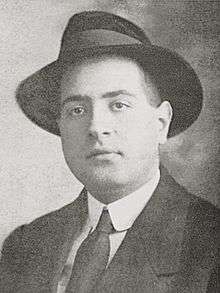Mário de Sá-Carneiro
Mário de Sá-Carneiro (Portuguese pronunciation: [ˈmaɾju dɨ sa kɐɾˈnɐi̯ɾu]) (May 19, 1890 – April 26, 1916) was a Portuguese poet and writer. He is one of the best known authors of the "Geração D'Orpheu", and is usually considered their greatest poet, after Fernando Pessoa.
Mário de Sá-Carneiro | |
|---|---|
 | |
| Born | May 19, 1890 Lisbon, Portugal |
| Died | April 26, 1916 (aged 25) Paris, France |
| Occupation | Poet and writer |
| Language | Portuguese |
| Signature |  |
Life
Mário de Sá-Carneiro was born to a wealthy family with a strong military tradition. His mother died in 1892 when he was two years old, and he was subsequently raised by his grandparents. He lived on a farm near Lisbon where he would spend most of his life. Sá-Carneiro started writing poems at the age of 12. By the age of 15, he had already translated several works by Victor Hugo. By 16, he had translated some works of Johann Wolfgang von Goethe and Friedrich Schiller. He began to write fiction in high school, partly due to his work as an actor. In 1911, he left for Coimbra, where he was admitted to law school, although he never progressed beyond his first year. However, he met a man who would soon become his closest friend, Fernando Pessoa, and who introduced him to the group of modernists of Lisbon.
After leaving the city of students, as Coimbra is known, Sá-Carneiro went to Paris to study at the Sorbonne. Although his father continued to pay for his studies, Sá-Carneiro stopped attending classes very soon after arriving in Paris. He lived a bohemian lifestyle, roaming round the theatres and bars.
It was in Paris that he met Guilherme de Santa-Rita (Santa-Rita Pintor), the legendary Portuguese painter.
Orpheu
Together with Fernando Pessoa and Almada Negreiros, he wrote for Orpheu, a literary journal of poetry and artistic prose influenced by cosmopolitanism and the European Avant-Garde. The magazine caused a scandal in Portuguese society because of its futuristic idealism. Only two issues of the magazine were published. A third one was prepared but never published, owing to the controversy surrounding the magazine and a lack of money. Today, Orpheu is known for being one of the finest and most important examples of Portuguese literature, and for introducing modernism in Portugal.
Depression

In July 1915, Sá-Carneiro returned to Paris by train. He planned, with Fernando Pessoa, to publish issue no. 3 of Orpheu, but his father and sponsor of the magazine, living in Mozambique at the time, refused to disburse more money. While World War I was in progress in the north of France, he left the university and started a relationship with a prostitute. A few months later, with growing financial problems and suffering from depression, Sá-Carneiro wrote a dramatic letter to Fernando Pessoa on March 31, 1916:
- "Unless there occurs a miracle, next Monday, March (or even the day before), your friend Mário de Sá-Carneiro will take a strong dose of strychnine and disappear from this world."
Extremely unhappy with his life, he still delayed the suicide by almost one month. But, as he had proclaimed, at the age of 25 he killed himself by swallowing a large dose of strychnine on 26 April 1916, at the Hôtel de Nice in the Montmartre district of Paris.[1] Orpheu nr.3 was never published.
Work

In 1912, he wrote his first play, Amizade (the title means friendship), in partnership with Tomás Cabreira Júnior. In the same year, he published Príncipio, a collection of novels.
In 1913, he published A Confissão de Lúcio, one of his most famous works. This novel has a story where the fantastic reigns and it's a mirror to this age of Avant-garde.
In 1915, the work Céu em Fogo, that gathered twelve novellas, was published. This book reveals the obsessions and disturbances that Sá-Carneiro was living with at the time.
Sá-Carneiro's first publication of poetry was Dispersão, published in 1913, which included twelve poems. He wrote another book, Indícios de Oiro, but it was not published until over twenty years after his death, in the magazine Presença. In 1946 these two books were published along with some of Sá-Carneiro's poems in the Orpheu magazine as a unique book.
His literary influences include Edgar Allan Poe, Oscar Wilde, Charles Baudelaire, Stéphane Mallarmé, Fyodor Dostoyevsky, Cesário Verde and António Nobre.
English poet Ted Hughes translated three of his poems into English.[2] American poet Sylvia Plath also admired his work, in particular his novel A Confissão de Lúcio (Lúcio's Confession).[3]
Centennial Anniversary of Mário de Sá-Carneiro's death
The 100th anniversary of Mário de Sá-Carneiro's death, on April 26, 2016, was highlighted in Portugal and abroad with a number of publications and events, such as the colloquium "Sá-Carneiro et les autres" (Paris), the exhibit "Mil Anos Me Separam de Amanhã" (Paredes de Coura), integrated in the festival Realizar-Poesia, an exhibit at the Biblioteca Nacional de Portugal, titled "Mário de Sá-Carneiro, 'O Homem São Louco'",[4] and a conference and audio-theatre at the Casa Fernando Pessoa.
References
- "Mário de Sá-Carneiro". Encyclopædia Britannica. Retrieved 30 April 2009.
- Ted Hughes’ Theory and Practice of Translation
- Do Orfeu a Sylvia Plath: Sá-Carneiro imortal, Observador, 1 May 2016 (Portuguese)
- "Mário de Sá-Carneiro, 'o homem são louco'". Biblioteca Nacional de Portugal (in Portuguese). Archived from the original on April 27, 2016.
Further reading
External links
- Mário de Sá-Carneiro Online
- Mário de Sá-Carneiro, Encyclopædia Britannica
- Works by Mário de Sá-Carneiro at Project Gutenberg
- Works by or about Mário de Sá-Carneiro at Internet Archive
- Works by Mário de Sá-Carneiro at LibriVox (public domain audiobooks)

- Mário de Sá Carneiro (1890-1916), Lisboa, Biblioteca Nacional, 1990
- Obras de Mário de Sá-Carneiro digitalizadas, Biblioteca Nacional Digital
- Biografia, Instituto Camões
- Mário de Sá-Carneiro, escritas.org